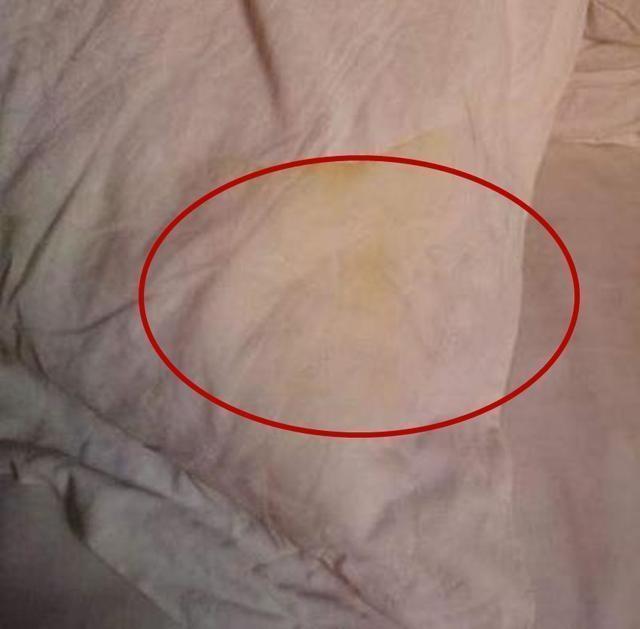
You’re changing the sheets, a mundane Sunday chore, when you notice them. Stains that weren’t there before. Not the usual, expected ones, but something different in color, texture, or location. It’s easy to dismiss them, but these mysterious marks are often the first, silent whistleblowers of a change in your partner’s health or habits. They are a forensic clue left behind by the body.
These unusual stains on your sheets mean your partner has… a bodily fluid or substance that is telling a story, and it’s one worth listening to.
Before jumping to conclusions, it’s important to approach this as a detective, not a prosecutor. Here’s a decoder for what those unusual stains might actually mean.
The Yellowish-Green or Greenish Stain: The “Infection Alert”
This is one of the most distinct and concerning colors. A greenish or dark yellow stain, especially one that has a thick consistency, is a major red flag.
- What it likely indicates: This color is classically associated with pus, which is a sign of infection. In an intimate context, this could point to a sexually transmitted infection (STI) like Gonorrhea or Trichomoniasis, both of which can cause a greenish-yellow discharge. It could also signal a significant yeast infection or bacterial vaginosis (BV).
- The takeaway: This is not a stain to ignore. It’s a strong visual indicator that your partner’s body is fighting an infection that requires medical diagnosis and treatment.
The Rusty Brown or Dark Brown Stain: The “Old Blood” Evidence
These stains look like dried blood, but darker and browner than the fresh, bright red of a minor cut.
- What it likely indicates: Brown stains typically mean old blood. This could be from:
- Vaginal Spotting: This can be normal around a period, but if it’s persistent, it could indicate hormonal fluctuations, cervical irritation, or other gynecological conditions.
- A Forgotten Tampon: A serious and dangerous situation that can cause a foul-smelling, brown discharge.
- Bleeding from Intense Friction: Sometimes, minor tearing can occur during sex, leading to small amounts of blood.
- The takeaway: While often benign, persistent brown staining warrants a conversation and potentially a doctor’s visit to rule out underlying issues.
The Thick, White, Clumpy Stains (Like Cottage Cheese): The “Yeast Overgrowth”
These stains are unmistakable—thick, white, and clumpy, resembling cottage cheese or ricotta.
- What it likely indicates: This is the classic sign of a yeast infection. It’s caused by an overgrowth of the fungus Candida, which is naturally present but can grow out of control.
- The takeaway: While uncomfortable, yeast infections are very common and highly treatable with over-the-counter or prescription antifungals. It’s a sign of imbalance, not a cause for alarm about the relationship.
The Oily, Greasy, or Waxy Stains: The “Topical Treatment” Trace
These stains feel greasy to the touch and don’t wash out easily. They often have a distinct, medicinal or lotion-like smell.
- What it likely indicates: Your partner is likely using a topical cream or ointment that they haven’t mentioned. This could be for a variety of reasons:
- A skin condition like psoriasis or eczema in the genital or inner-thigh area.
- Hemorrhoid cream.
- A medicated cream for a jock itch or fungal infection.
- The takeaway: This stain points to a private health concern your partner may be embarrassed to discuss. It’s a sign to approach them with care and concern, not suspicion.
The Gritty, Crystalline Stains: The “Dehydration” Crystal
These are less common but noticeable. They feel slightly gritty or sandy and may have a faint, ammonia-like smell.
- What it likely indicates: This can be a sign of concentrated urine or urinary crystals. The primary culprit is often simple dehydration. When the body is dehydrated, urine becomes more concentrated and can leave behind these crystalline residues.
- The takeaway: It’s a nudge for both of you to drink more water. If accompanied by pain during urination, it could signal a kidney stone or UTI and should be checked by a doctor.
How to Have the Conversation
The goal is understanding, not accusation. Instead of “What is this stain?” try a more compassionate approach:
“I was changing the sheets and noticed a stain I hadn’t seen before. I just want to make sure you’re feeling okay, physically. Is there anything going on that you’d like to talk about or that we should get checked out?”
These unusual stains on your sheets are more than just a laundry problem. They are messages. They can be signs of a common and treatable infection, a need for better hydration, or a signal that your partner is dealing with a private health issue. By paying attention and communicating with empathy, you can transform a moment of confusion into an opportunity for care and support.